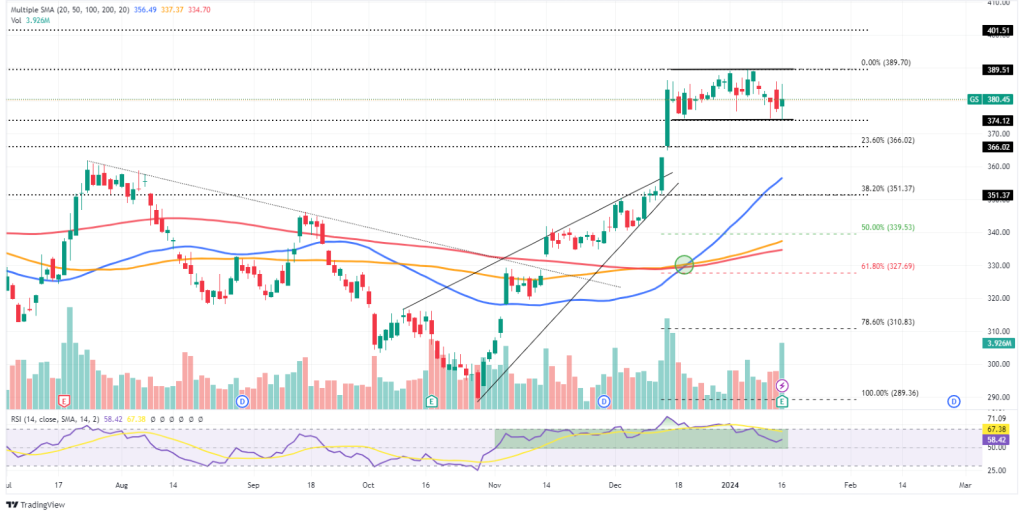
Goldman Sachs Group, Inc. (NYSE: GS) recent quarterly results present a tale of contrasting threads, weaving a narrative of financial prowess amidst challenges. While overall profit surged 51% to just over $2 billion and revenue exceeded expectations at $11.3 billion, sending shares modestly higher, the mixed results across its business segments suggest the narrative within the banking giant is decidedly bifurcated.
The key driver of the strong performance was the asset and wealth management division, where revenue soared 23% to $4.39 billion. This segment benefited from rising stock prices and increased wealth among high-income families and institutions. Equity trading revenue also shone, jumping 26% to $2.61 billion on the back of a buoyant stock market.
However, Goldman’s traditional powerhouse businesses, investment banking and trading, delivered lacklustre results. Investment banking fees dipped 12% to $1.65 billion, reflecting a slowdown in deal activity due to rising interest rates. Fixed-income trading revenue plunged 24% to $2.03 billion, mainly due to struggles in the rates and currency areas.
Despite the mixed results, Goldman CEO David Solomon expressed optimism for 2024. He highlighted the bank’s “clear and simplified strategy” and a “stronger platform” built on the back of its 2023 achievements. He also pointed to the potential for a resurgence in M&A activity and rate cuts in the first half of the year as positive catalysts.
Technical
The 4-hour shows that the price is holding steady at $380.45, residing within a horizontal trading range. The prevailing market sentiment is reflected in the price action, which is comfortably above the 50-SMA (blue line), 100-SMA (orange line), and 200-SMA (red line).
The recent crossover of the 50-SMA above the 100-SMA and 200-SMA indicates a favourable shift in short-term momentum. Despite the flat RSI at 58.42, signifying a balanced market, the stock is poised within a horizontal consolidation, presenting short-term trading opportunities.
With the price action confined within a horizontal consolidation zone, short-term trading opportunities could exist as the price action oscillates between the $389.51 resistance level and the $374.12 support level.
A break above the $389.51 resistance level would leave the $401.51 resistance level within the bulls’ reach in the short term. However, a sustained push and a break below the $374.12 support level could offer trading opportunities towards the support level at $366.02 and $351.37 support levels lower.

Summary
Goldman Sachs’ Q4 earnings present a mixed picture, with solid performance in asset and wealth management offset by weakness in investment banking and trading. Technically, the stock is consolidating after the initial post-earnings rally, with the near-term outlook uncertain.
A break above $389.51 could signal further upside towards $401.51, while a sustained push below $374.12 could lead to a test of $366.02 and potentially $351.37 lower.
Sources: TradingView, Trading Economics, Reuters, Goldman Sachs Group, Financial Times, Dow Jones Newswire.
Piece written by Mfanafuthi Mhlongo, Trive Financial Market Analyst
Disclaimer: Trive South Africa (Pty) Ltd (hereinafter referred to as “Trive SA”), with registration number 2005/011130/07, is an authorised Financial Services Provider in terms of the Financial Advisory and Intermediary Services Act, 37 of 2002. Trive SA is authorised and regulated by the South African Financial Sector Conduct Authority (FSCA) and holds FSP number 27231. Trive Financial Services Ltd (hereinafter referred to as “Trive MU”) holds an Investment Dealer (Full-Service Dealer, excluding Underwriting) Licence with licence number GB21026295 pursuant to section 29 of the Securities Act 2005, Rule 4 of the Securities Rules 2007, and the Financial Services Rules 2008. Trive MU is authorized and regulated by the Mauritius Financial Services Commission (FSC) and holds Global Business Licence number GB21026295 under Section 72(6) of the Financial Services Act. Trive SA and Trive MU are collectively known and referred to as “Trive Africa”.
Market and economic conditions are subject to sudden change which may have a material impact on the outcome of financial instruments and may not be suitable for all investors. Trive Africa and its employees assume no liability for any loss or damage (direct, indirect, consequential, or inconsequential) that may be suffered. Please consider the risks involved before you trade or invest. All trades on the Trive Africa platform are subject to the legal terms and conditions to which you agree to be bound. Brand Logos are owned by the respective companies and not by Trive Africa. The use of a company’s brand logo does not represent an endorsement of Trive Africa by the company, nor an endorsement of the company by Trive Africa, nor does it necessarily imply any contractual relationship. Images are for illustrative purposes only and past performance is not necessarily an indication of future performance. No services are offered to stateless persons, persons under the age of 18 years, persons and/or residents of sanctioned countries or any other jurisdiction where the distribution of leveraged instruments is prohibited, and citizens of any state or country where it may be against the law of that country to trade with a South African and/or Mauritius based company and/or where the services are not made available by Trive Africa to hold an account with us. In any case, above all, it is your responsibility to avoid contravening any legislation in the country from where you are at the time.
CFDs and other margin products are complex instruments and come with a high risk of losing money rapidly due to leverage. You should consider whether you understand how these products work and whether you can afford to take the high risk of losing your money. Professional clients can lose more than they deposit. See our full Risk Disclosure and Terms of Business for further details. Some or all of the services and products are not offered to citizens or residents of certain jurisdictions where international sanctions or local regulatory requirements restrict or prohibit them.




